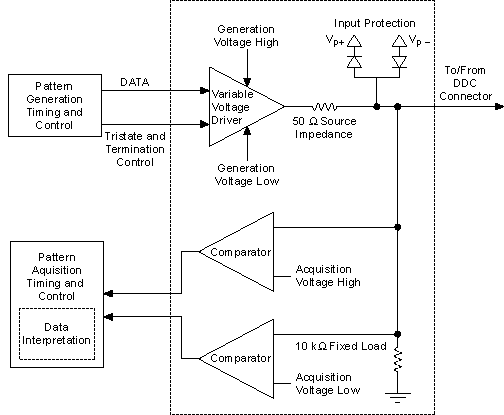Channel Electronics
The channel electronics of the NI 655x devices consist of a variable voltage driver, dual comparators, the appropriate termination resistors, and I/O protection diodes. Each I/O channel is capable of simultaneously driving and receiving data.
The following figure provides a basic block diagram for the channel electronics. Refer to NI 655x Block Diagram for a picture of how the channel electronics fits into the overall block diagram.

Dynamic Generation
For dynamic generation operations, the data appears at the input of the variable voltage driver after the Pattern Generation Timing and Control module gives the data the selected data position and data delay. The variable voltage driver converts the data signal to the user-defined voltage levels (Generation Voltage High and Generation Voltage Low) before sending the data signal to the DDC connector on the NI 655x front panel.
The variable voltage driver can be set to high-impedance generation with the Tristate control line. The Tristate control can be set automatically by the Initial and Idle States or can be set programmatically with the niHSDIO Tristate Channels VI or niHSDIO_TristateChannels function. When a channel is configured for open collector generation, the tristate control transforms logic 1's into Z states (high-impedance).
The protection diodes are critical for guarding against overvoltage situations.
Dynamic Acquisition
Patterns acquired by the NI 655x are received using a dual-comparator architecture. One comparator is assigned to each acquisition threshold (Acquisition Voltage High and Acquisition Voltage Low).
The output of the dual comparators are combined into a single bit using the selected data interpretation method. The data is sampled by the Pattern Acquisition Timing and Control module before being sent to the Pattern Acquisition Engine for storage into Acquisition Memory.
You can programmatically set the input impedance to high impedance or 50 Ω, referenced to ground.